Apr 5, 2017 Boban Docevski

Today, the practice of torture as a form of punishment is forbidden in most parts of the world, but the dark legacy of the middle ages is still here to remind of the cruelty we are capable of.
Over centuries people have invented all sorts of torture devices, but when it comes to pain-inflicting design nobody was as “creative” as those Middle Age torturers. Here is a selection of some of the most terrible torture devices that were ever made.
1 Breast Ripper
This instrument of torture, also known as the Iron Spider, was usually used on women who had committed adultery or performed an abortion.
It was also used to hurt women that were accused of heresy, blasphemy or witchcraft. The Breast Ripper was made to rip-off the breasts of the woman who were sinners.
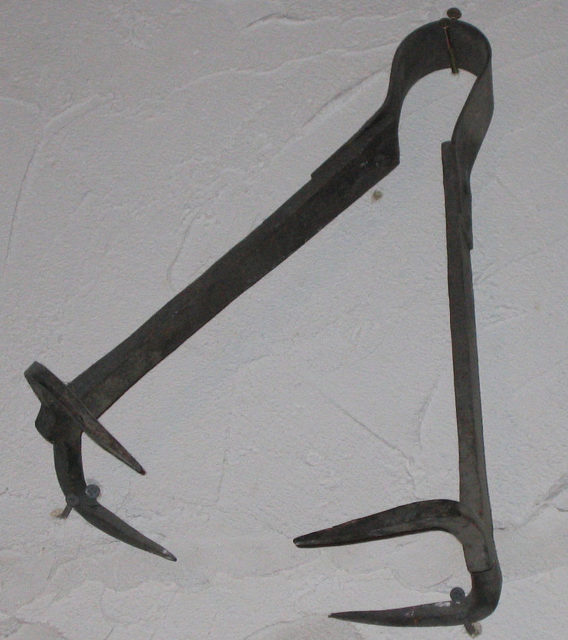
A Breast Ripper from the 15th-century
Often heated up to high temperatures, the four claws of the Ripper would slowly rip apart the poor woman’s breast. If the victim didn’t die from the excruciating pain and inflicted wounds, she remained disfigured for the rest of her life. Another form of this device, called the Spider, was attached to a wall, with the woman’s breasts attached to it; then she was pulled away from the wall until her breasts were torn apart.
2 Stocks
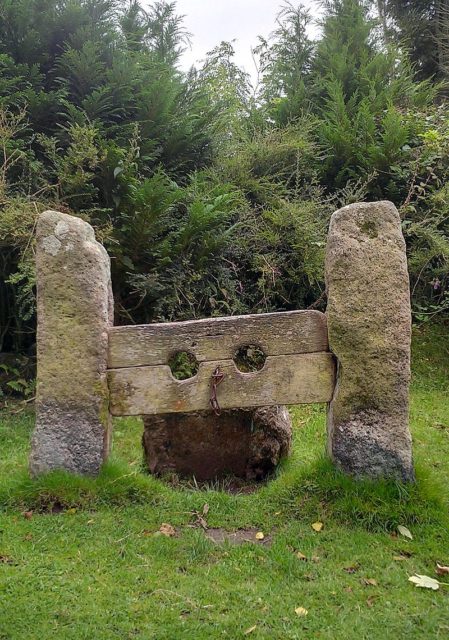
Medieval stocks at Belstone in Dartmoor
The Stocks were a public torture device that immobilized the feet of the punished person. They were usually placed in public spaces like marketplaces or squares where people could throw rotten food or other objects at the immobilized person. People were also allowed to kick, spit and insult the person that was being punished.
The Stocks, similar to the Pillory device, were made of two large hinged wooden boards, between which the feet of the victim were locked. In some cases, the hands of the person were also chained. The hinged boards were placed around the ankles, and the feet of the person were usually bare. That made the humiliation even greater. The Stocks were always placed outdoors, so the victim was exposed to the elements for days.
3 Wooden horse (Spanish Donkey)
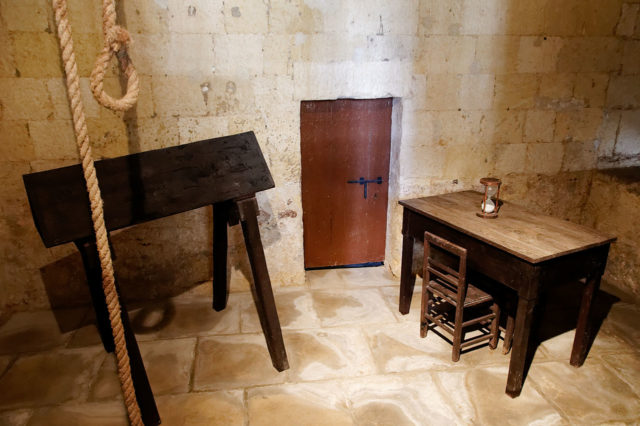
The Wooden Horse is the device on the left (picture taken at the Inquisitor’s Palace, in Birgu) Photo credit
This painful torture device is also known as Cavaletto or Squarciapalle (depending on the country where it was used). It came in varieties, both of which caused pain using the victims own weight while spreading the legs. The victim (usually a woman) was tied with ropes hanging from the ceiling, slowly lowered down over the device.
The device itself consisted of a triangularly shaped piece of wood (with sharp edges) that was placed over a sawhorse with an edge of the triangle pointing upward toward the victim. The person that was being punished was then forced to straddle the “horse.” If this wasn’t painful enough, the torturers tied weights to the legs of the victim, to pull the down even harder. Although the device was designed mainly for women, there are accounts that it was also used on men.
4 Scold’s Bridle
This mask-like head enclosing device was a terrible public humiliation tool from medieval times.
Also known as Witch’s Bridle, a Brank’s Bridle, or Branks, this torture device was usually used on women that were accused of being loud, rude, or “common scolds.” Often, those women were also under suspicion of witchcraft.
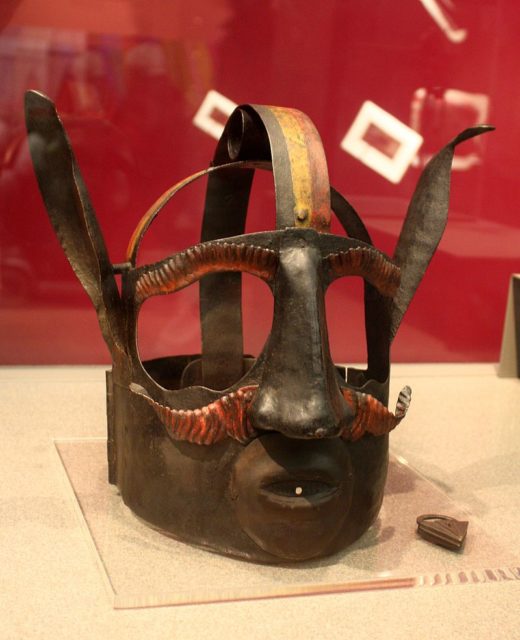
A Scottish Scold’s Bridle
This device was used to stop them speaking and prevent them spreading “gossips or scolds.” or enchant people. The Scold’s Bridle had an iron muzzle held by an iron frame that was made to fit around the head. A 2 inches long and 1-inch broad metal harness went inside the mouth of the woman and pressed down her tongue, making her unable to speak. Some of the Sold’s Bridles also had a bell attached at the top so that the punished person could attract more attention while walking around in public places. That caused even greater humiliation.
5 Iron Maiden
No, it is not the famous heavy metal band but the medieval torture device that has the same name. The Iron Maiden is probably one of the most famous torture devices, mostly because of its wide usage in pop culture.
The original Iron Maiden (Eiserne Jungfrau in German) was made sometime around the 14th century, in the German town of Nuremberg and its design reminded of an Egyptian mummy sarcophagus. The Iron Maiden is an iron cabinet that opens to reveal a spike-covered interior.
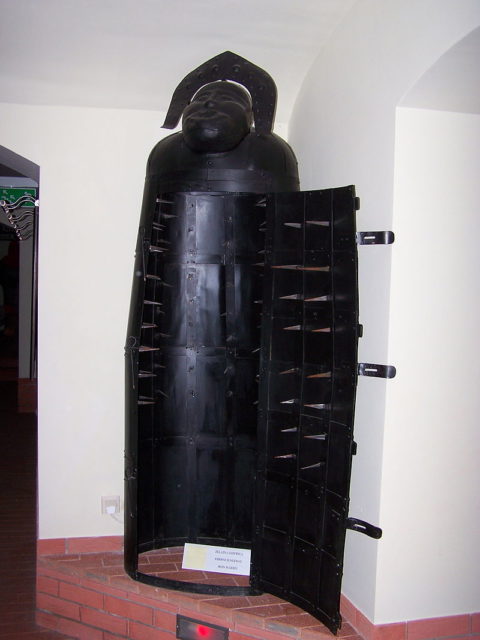
An iron maiden
It is shaped to fit an average person inside. It is said that it was used for slow and painful executions. Most of the stories concerning the Iron Maiden were invented in the 19th century, by a man called Johann Philipp Siebenkees. He claimed that the Iron Maiden was first used on August 14th, 1515, for the execution of a coin forger.
Today, several Iron maidens from the 19th century can be seen in museums around the world, but none of them were used as actual torture devices. The original Nuremberg Iron Maiden which was destroyed in the Allied bombing of Nuremberg in 1944.
6 Pillory
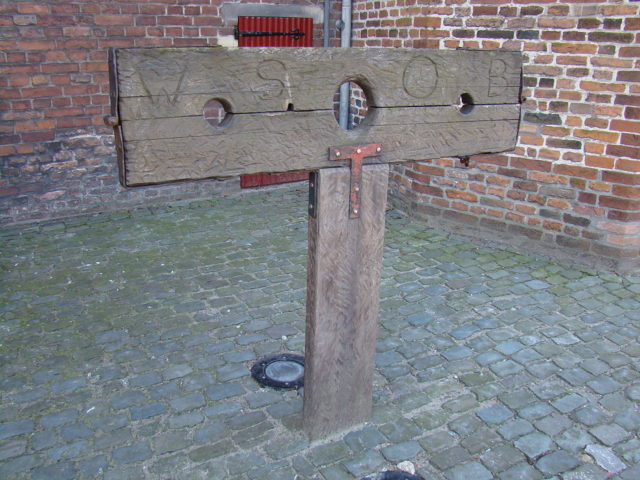
A Pillory device
Similar to the already mentioned Stocks, the pillory was a torture device made for public humiliation of criminals and culprits in marketplaces, Crossroads, and other public places. The word originates from Old French “pellori,” or the Latin “pelloria” and it is probably a diminutive form of the Latin “pila,” meaning “pillar, stone barrier.” This was a popular method of public humiliation in many countries until the 19th century. The Pillory was usually made out of two hinged wooden boards with holes for the head and limbs.
The punished person was locked between the boards. The position in which he was placed, bent forward with his hands and head in front, was very uncomfortable. When a person was put in a pillory, people from all around town would gather and commence the humiliation by taunting, teasing and insulting the man. The idea was to make the experience as painful and bad as possible for the victim. People would then start throwing rotten food, mud, animal corpses and excrement towards the person. At the end of the humiliation, the criminal was left very dirty and smelly, with his pride injured. In some cases, people were even killed on the pillory. Violent crowds sometimes threw lethal objects such as rocks and bricks towards the victim. As a legacy of this device, the modern English vocabulary has the verb “to pillory,” which means to humiliate someone in front of witnesses.
7 Heretic’s Fork
This simple yet dangerous and painful device had the word “abiuro” (“I recant”) engraved on it. Those who were tortured with it recanted very quickly. The Heretic’s Fork was an iron rod which had bi-pronged forks on both sides.
The middle of the iron rod had a buckle through which a belt was attached. It was made to be placed between the breastbone and throat just under the chin. It was then tied around the neck with a leather belt. The person being tortured with this terrible device was never allowed to lie down; instead, he was suspended in an upright position. The device made the victim unable to talk. The slightest movement caused huge pain. Also, sleep was out of the question for the victim.
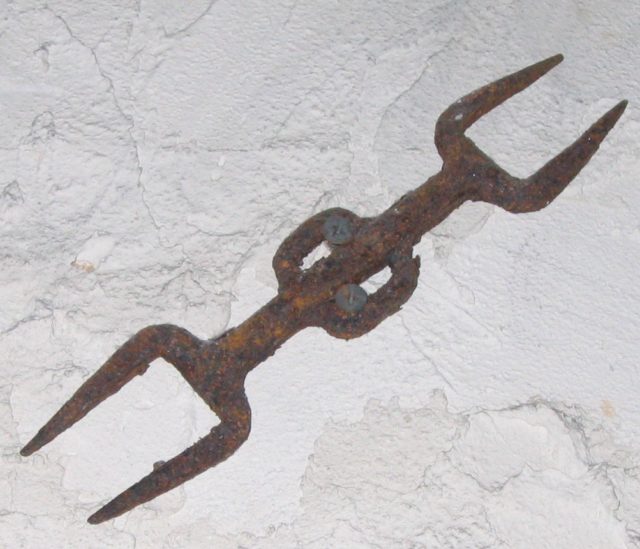
A heretic’s fork (without the strap)
If a person fell asleep, the forks would pierce its throat troat or chest causing pain. People were left sleep-deprived for days in this agonizing position, and a confession was almost always guaranteed. The Inquisition used the heretic’s fork on blasphemers and liars or other people who spoke the name of God in vain.
8 The Spanish Boot (foot press)
The Spanish Boot was not the latest fashion of footwear that was popular in medieval streets; it was a gruesome torture tool.
One variety of this device called the Foot Press had two horizontal iron plates that were designed to squeeze around a foot with a crank mechanism. At one point, they would press enough and crush the poor person’s foot bones. Another model of the same device had sharp spikes coming out of the upper plate.
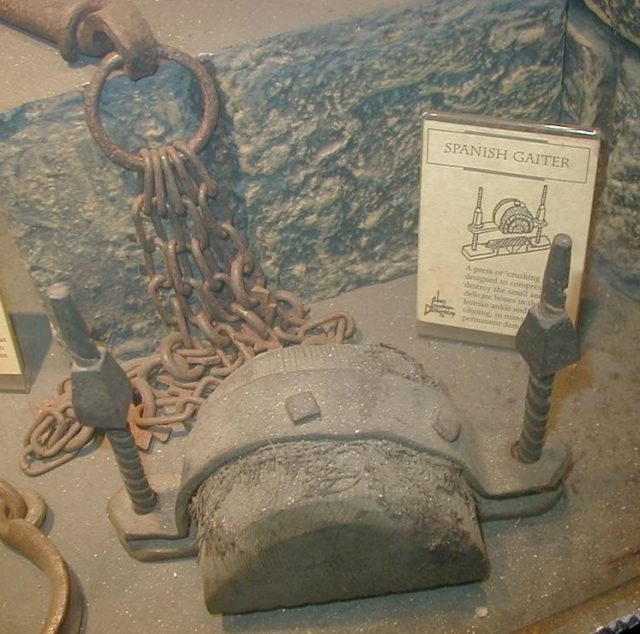
A Spanish Boot
They held the foot in place and caused additional pain and destruction. A similar device from Venice had a drill attached to the crank mechanism too. The drill would run trough the foot while the press crushed the bones. This would leave the victim with an entirely crushed foot. This torture device often came with different extensions, some of those were designed for crushing ankles, some of them for calf and knees. The foot press often left the toes visible and open so that additional damage could be done to them with different torture methods.
9 Death by sawing
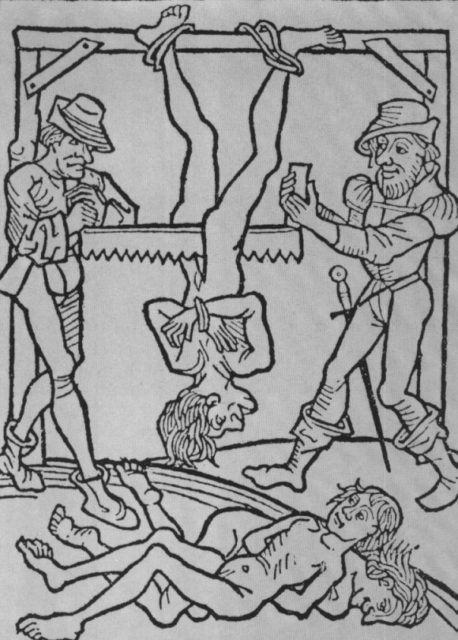
A depiction of death by sawing on a 15th-century print
This torture (or rather execution) method is pretty much self-explanatory. A saw was used to cut the victim in half. In some cases, it was done horizontally (splitting the body in half at the stomach area), while in other cases vertically (cutting the body along the spine). Although many of the stories about death by sawing are mythological and legendary, there are reports from all over the world that give detailed explanations of how this gruesome act was done.
Different methods have been mentioned throughout history. Usually, the “death by sawing” was done lengthwise, either from the groin upwards or from the skull downwards. In one case, it is mentioned that a person was hanged upside down and sawn vertically from the groin to the head. Some of the more detailed accounts even explain that the victims were fastened to one or two wooden boards before being cut.
10 Breaking Wheel
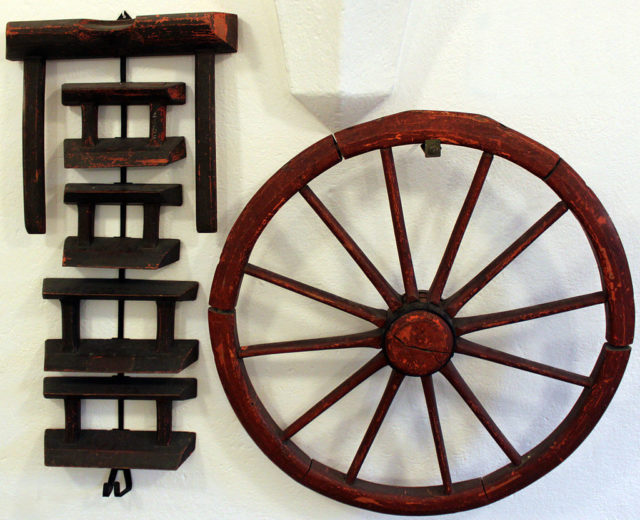
A breaking wheel
The breaking wheel is another terrible method of capital punishment. This form of punishment was used over many centuries, probably up until the early 19th century. The breaking on the wheel involved crushing the bones of a criminal by hitting him to death with a blunt object.
The historical artifacts show that the breaking wheels were usually big wooden wagon wheels with many radial spokes. Those that were to receive the punishment were tied on the wheel and then beaten with a club or some other kind of blunt weapon. The gaps in the wheel allowed for the victim’s bones to be broken while he was beaten. Another method involved the criminal being spread and tied down on a big wooden cross in an X shape (saltire). After he had been crushed on the saltire, he was then publically displayed on the wheel. According to some medieval accounts, the victim could survive for a few days after being broken. A 14th-century murderer was supposedly alive for three days after he was punished on the wheel.
The Legenda Sanctorum (The Golden Legend) speaks about the execution of St. Catherine of Alexandria. After St. Catherine refused to renounce her Christian faith, she was sentenced to be broken on the wheel. The wheel miraculously broke when she touched it. Because of her, the breaking wheel is also called Catherine Wheel.
11 The Rack
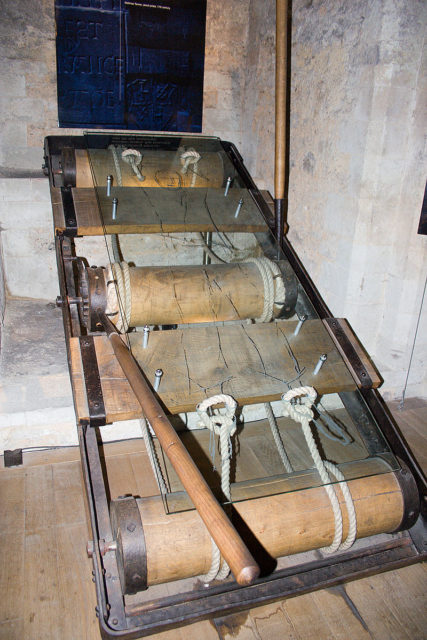
The rack in the Tower of London
Another very popular medieval torture device was the so-called rack. The rack was constructed of a rectangular, iron or wooden, frame that was positioned at a particular angle from the ground. The frame had a wooden roller at one or sometimes at both ends. The person that was being interrogated was tied down over the frame; his wrists on one roller and his ankles on the other. During the torturous interrogation, a handle was pulled by the interrogator, which increased the tension of some chains. As the chains tightened, the body of the victim stretched, causing a lot of pain. The roller could also twist around its axis and additionally strain the ropes. Ultimately, the joints of the victim were dislocated or even separated. Even thinking about this torture method causes shivers around the body.
When the rack was being extremely stretched, besides the excruciating pain, the victim would also hear the popping noises produced by the snapping of his cartilage, ligaments and the breaking of his bones. Victims of the rack were usually left with separated shoulders and hips and dislocated elbows, knees, wrists, and ankles.
12 Head Crusher
Another device whose name is self-explanatory. The Head Crusher was only used in Germany, where it was known as “Kranz” or “Schneiden.” It consisted of a metal plate that was positioned beneath the jaw of the tortured person, connected to a head cap with a twisting handle.
As the handle was turned, the head cap was pushing against the skull, slowly crushing it. If this process continued long enough, the whole skull, together with the teeth, jaw and facial bones was destroyed, resulting in death. On the other hand, if the interrogator stopped turning the handle before the person was dead, he would probably end up with a huge facial damage. His jaw would be crushed, and his eyes popped out from the sockets. The head crusher was a device that was often used to extract information from dangerous criminals.
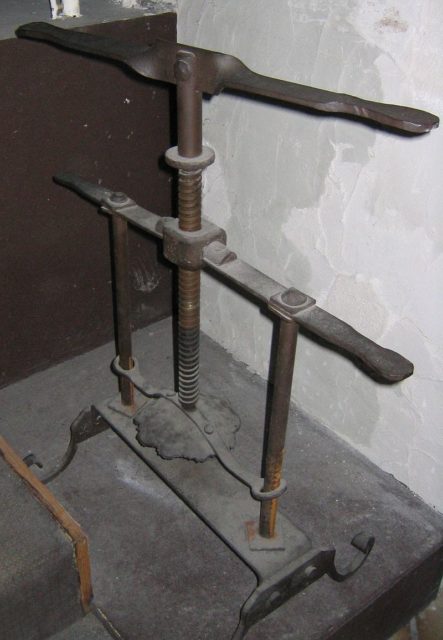
Head crushing device
13 Judas Cradle
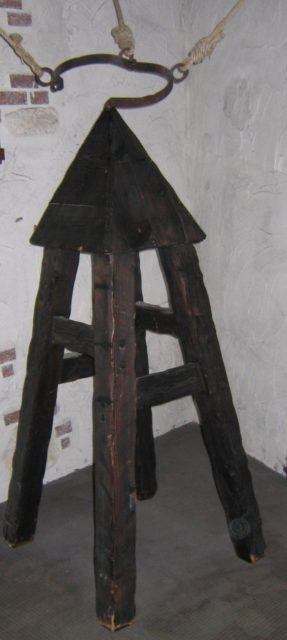
Judas Chair
This awful torture device resembles the wooden horse, and it was made to penetrate a person in a highly painful way. The Judas cradle was made of a pyramidal piece of wood that was attached on four wooden legs. According to some old accounts, the tortured person would be placed in a specially designed waist harness which was hanging from the ceiling, and then slowly lowered “into position.”
The tip of the pyramid was inserted into a person’s “opening,” stretching it and causing unbelievable pain. At some point, the muscle tissue around the victim’s opening would tear apart and, ultimately, kill the impaled person. Although similar to the Wooden Horse torture device, the Judas cradle wasn’t made only to rupture the skin and hurt; it was made to mutilate the genitals of a person.
14 Thumbscrew
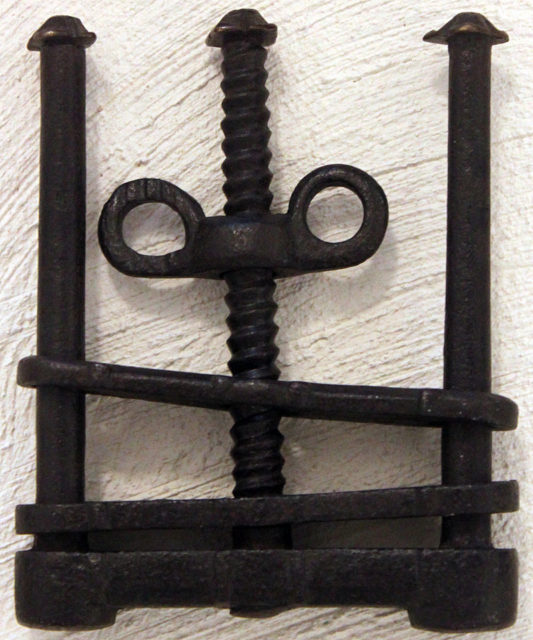
Thumbscrew
This medieval torture device was designed with only one purpose – to destroy people’s thumbs and toes. The thumbscrew was a simple small device in which the tortured person’s thumbs or toes were placed and slowly crushed. The metal bars that crushed the thumbs were sometimes “decorated” with small spikes that caused much pain to the victim (especially in its nail beds).
15 Strappado
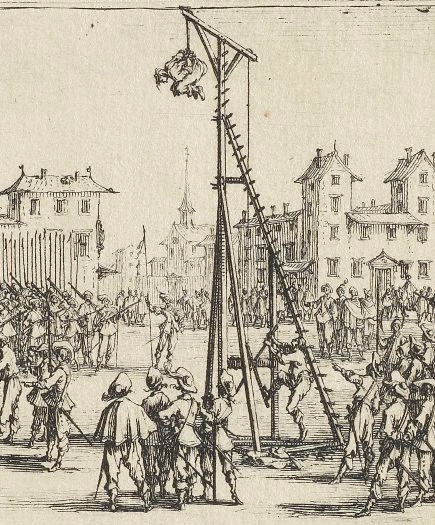
An illustration of a strappado torture device
The Strappado may look like some sort of a medieval bungee jumping contraption, but, of course, it’s not. If it were, it wouldn’t be found on this list. The Strappado, or the Corda, as it was also known, was a Medieval method of torture which tied the hands of a person behind his back and suspend him in the air, using a rope that was attached to the wrists.
This practice left the victim with some dislocated shoulders. In many cases, weights were attached to the body of the tortured person. The additional weight increased the pain. Usually, sessions on the Strappado lasted for an hour and were repeated again if necessary. If a person were left to hang like that for a longer period without rest, death would probably occur. When it was “properly” done, Strappado caused some permanent and visible damage on the body of the victim. Strappado was a method which was mostly used by the Inquisition.
16 Shrew’s Fiddle
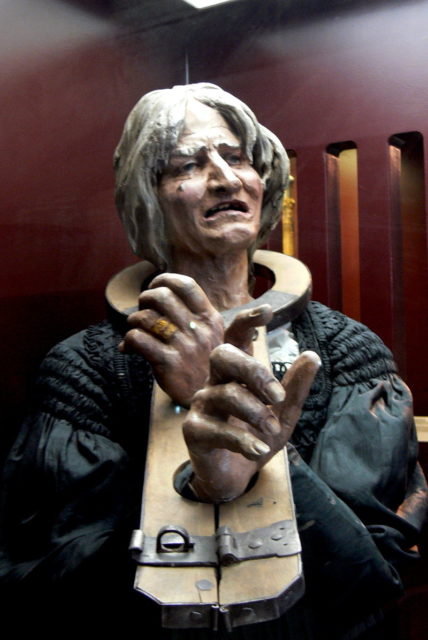
A model of a person trapped in a shrew’s fiddle device
This device, known as shrew’s fiddle or neck violin, is similar to the pillory, but instead of being immobilized, the person trapped inside was able to move. The fiddle had two wooden boards with a hinge which locked the both together. It had three holes, one for the head and two smaller holes for the wrists which were placed in front of the face. The shrew’s fiddle was a device used to punish women that were fighting or arguing. It was predominantly used in Germany and Austria. There was also a bigger version of the fiddle, made to fit two women facing each other. The entrapped women were released from the contraption only after their argument was settled.
17 Pear of Anguish
Although credited as being invented in medieval times, the true origin and use of the pear of anguish is still not precisely determined.
The Pear of Anguish is made of a pear-shaped metal body which can be separated (spread) into a few spoon segments by turning a screw located on the handle of the device. According to some descriptions, the pear was probably used for one of these two reasons: to gag people and prevent them from speaking, or as a torture tool made to penetrate into the mouth of a person. According to one 19th century account, the Pear of Anguish was used by Dutch robbers.
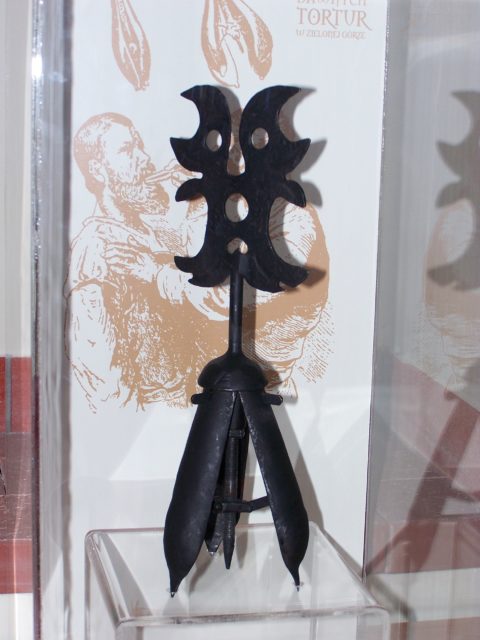
Pear of Anguish
They would force it inside the mouth of a victim and then turn the key. When the internal springs would release the spoons in the mouth, the device could be released only by the proper key.
However, it remains unclear whether that was its real purpose.
18 Iron Chair

An Iron Chair
This uncomfortable chair is purposely made to cause all sorts of pain. It has many different names and models depending on the country where it was used and made: the Chinese torture chair, the torture chair, or the Iron Chair.
The one pictured above was made with hundreds of little spikes spread all over the sitting and leaning surface. This kind of chairs had from 500 to 1500 spikes. The victims were usually tied to one of these chairs and gradually pushed closer to a blazing fire, being slowly roasted alive while the spike penetrated their body.
19 Scavenger’s daughter
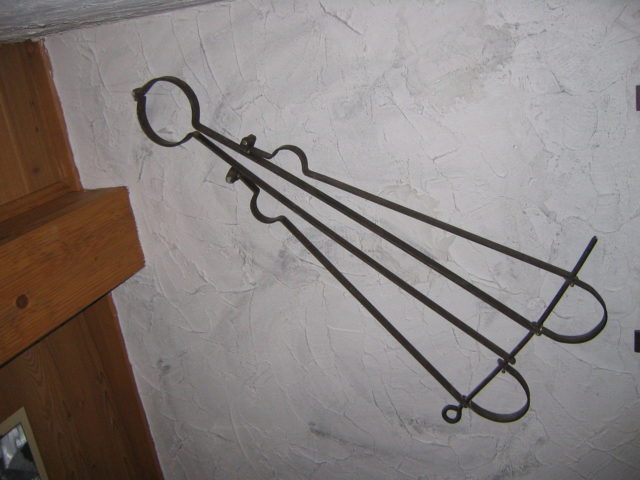
A Scavenger’s Daughter device
Scavenger’s Daughter (or Skevington’s Daughter) was a device made by Sir Leonard Skevington, Lieutenant of the Tower of London, and son of Sir William Skeffington, Lord Deputy of Ireland. This A-frame metal rack was designed to do the opposite of the rack (which was also known as the Duke of Exeter’s Daughter).
Instead of spreading the body of the tortured man, Scavenger’s Daughter compressed the body of a person to its limits. The metal A-frame was designed so that the head could be tied to the top of the A, the hands at the middle, and the legs could be tied at the bottoms of the frame. The head was then forced down, the knees up, and the whole body compacted so that blood could get out from the nose and ears. Not much is known about this device because it was probably rarely put into action.
20 Tongue Tearer
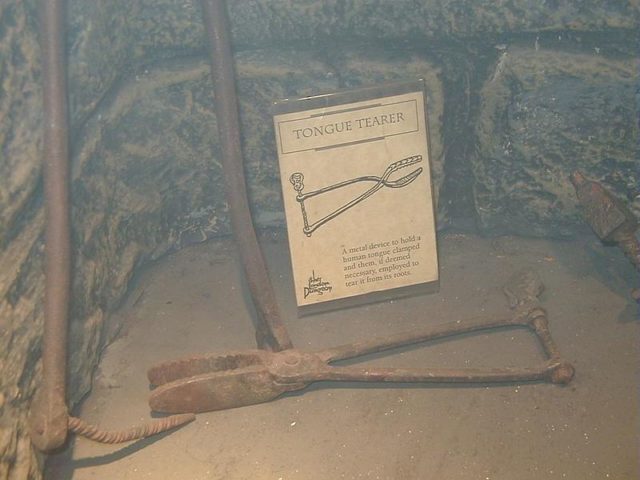
Tongue Tearer
This large pair of scissors were not designed to cut anything else but the tongue of a person.
Read another story from us: Lingchi, the Chinese torture, and execution method used against criminals responsible for high treason and patricide
First, his or her mouth would be opened with the mouth opener tool to allow the tongue tearer to be placed inside, grabbing the tongue. Once in place, the screw on the other end was slowly turned and tightened until the tongue of the victim was completely torn apart.
We hope you are enjoying The Vintage News. Please consider helping us with our journey to bring popular historical content to everyone by becoming a supporter today. Thanks.
No comments:
Post a Comment
Note: Only a member of this blog may post a comment.